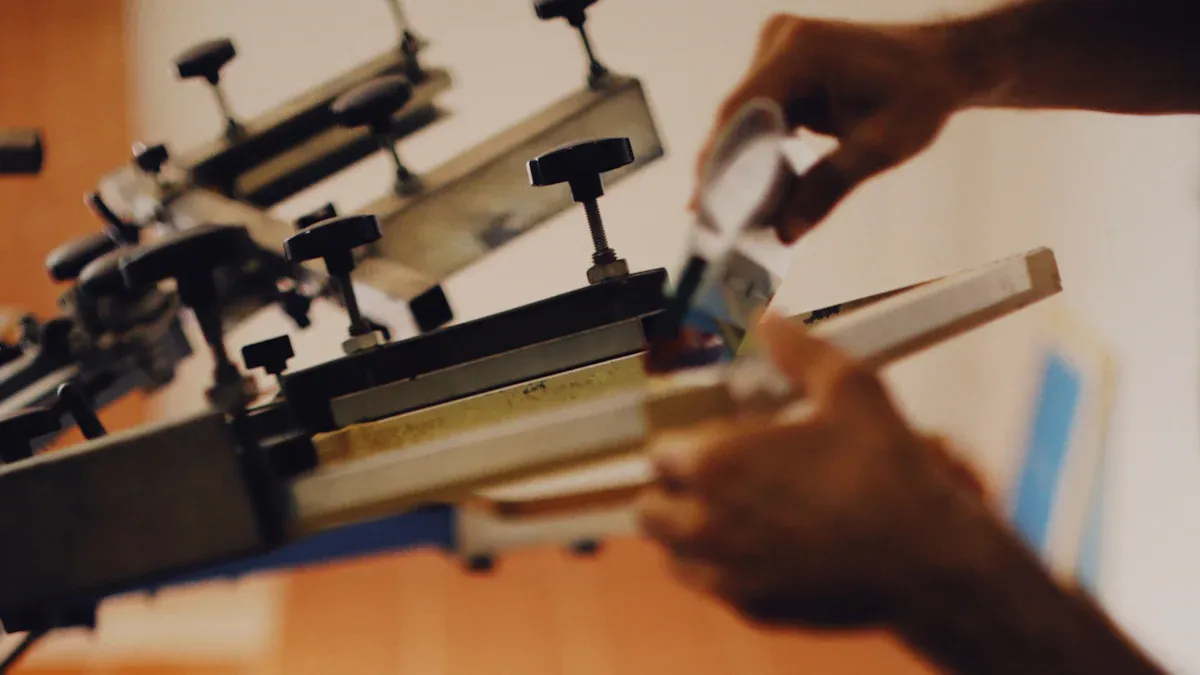How to Maximize Profits in Custom T-Shirt Business

The custom t-shirt business has many chances to make money. Profits can be between 30% and 60%, especially with unique designs like Hawaiian prints. Some people even earn over $100,000 a year! To do well, focus on three things: setting the right prices, promoting your shirts well, and using tools like print-on-demand. Platforms like Yoycol help you save money and skip keeping stock. By following these steps, you can turn your ideas into a successful business.
Understanding Profitability in the Custom T-Shirt Business
Industry Growth and Market Trends
The custom t-shirt business is growing fast and shows no signs of stopping. The market was worth $3.5 billion in 2020 and could reach $6.10 billion by 2028. This means it’s growing at a rate of 9.7% each year! Why is this happening? People want custom t-shirts for branding, ads, and personal style. As people earn more money, they spend more on unique and high-quality designs.
Another big trend is the love for personalized clothing. Companies use custom t-shirts to promote their brands. Customers enjoy wearing designs that match their interests or personality. This trend increases demand and lets you charge higher prices. Higher prices mean better profits for your business.
If you want to start or grow your custom t-shirt business, now is a great time. The market is expanding, and creative business owners have many opportunities to succeed.
Key Factors Influencing Profit Margins
Making good profits depends on several important things. Let’s look at what affects your profit margins:
Material Costs: Fabric choice matters a lot. Better materials cost more but let you charge higher prices. Cheap materials can hurt your brand and upset customers.
Printing Methods: Printing techniques have different costs. Screen printing works well for big orders. Direct-to-garment (DTG) printing is great for small, detailed designs. Picking the right method helps balance quality and cost.
Market Trends: Knowing what’s popular gives you an advantage. T-shirts with trendy designs or pop culture themes sell for more, boosting profits.
Pricing Strategies: Setting fair prices is key. Cover your costs but stay competitive. Adjust prices based on customer feedback and market demand.
Here’s a simple table showing factors that affect profit margins:
Key Elements | Description |
|---|---|
Market Size | How big the custom t-shirt market is and its growth potential. |
Drivers | Reasons for market growth, like branding and demand for custom products. |
Competitive Analysis | Study of competitors and how they affect your profits. |
SWOT Analysis | Strengths, weaknesses, opportunities, and threats in the market. |
Pricing Analysis | How pricing strategies impact profit margins. |
Macroeconomic Indicators | Economic factors that influence market growth and profits. |
COVID Impact | Effects of the pandemic on market trends and profits. |
Market Dynamics & Outlook | Future trends and challenges that may affect profits. |
Regional Market Size | Market share by location, showing areas of growth and profit. |
By learning about these factors, you can make better choices to increase profits. Whether it’s picking the best materials, using cost-effective printing, or following trends, every decision matters.
Managing Production Costs in Custom T-Shirts

Material Costs and Quality
The fabric you pick affects cost and shirt quality. Better materials like organic cotton cost more but allow higher prices. Customers enjoy soft and strong t-shirts that feel good to wear. Cheaper fabrics save money but might disappoint customers and hurt your brand.
Think about your buyers when choosing materials. Do they want eco-friendly shirts or cheaper options? Organic cotton is great for green-minded shoppers. Standard cotton works for budget designs. Match your materials to your brand and customer needs.
Printing Methods and Their Cost Implications
Printing choices impact your spending. Screen printing is good for big orders since setup costs spread out. It’s not ideal for small batches or detailed designs because each color needs a screen. Direct-to-garment (DTG) printing works well for small orders and complex designs. It prints straight onto the shirt for great results.
Heat transfer is cheap for small runs but doesn’t last as long. Embroidery costs more but looks fancy and appeals to high-end buyers. Pick a printing method based on your budget, order size, and design style.
Equipment and Labor Costs
Making shirts yourself can be pricey. Machines like screen printers or DTG printers cost a lot. Repairs and upkeep add to expenses. Skilled workers make quality shirts but increase labor costs.
Outsourcing production can save money and time. Services like Yoycol handle printing and shipping for you. This way, you can focus on designing cool shirts and growing your business without production worries.
Pricing Strategies to Boost Profits
Keeping Prices Fair and Building Brand Value
Setting the right price is very important. If your t-shirts are too cheap, people might think they’re low quality. If they’re too expensive, buyers might go elsewhere.
Think about what makes your t-shirts special. Are your designs unique? Do you use high-quality fabrics? Show customers why your shirts are worth the price. For example, if you use organic cotton or detailed artwork, people may pay more. Being competitive doesn’t mean being the cheapest. It means giving the best value for the price.
Knowing Your Costs to Set Prices
To price your shirts well, you need to know your costs. This includes fabric, printing, labor, and shipping. Once you know these, add a profit margin that matches your goals.
Here’s a simple table to help:
Pricing Method | What It Means | Example |
|---|---|---|
Cost-Plus Pricing | Add a fixed profit to your costs. | A business adds a set percentage to its production costs. |
Value-Based Pricing | Price based on how much customers value it. | Charge more for eco-friendly or artistic t-shirts. |
Dynamic Pricing | Change prices based on demand and trends. | Offer discounts in slow months or raise prices for rare designs. |
Pick the method that works best for your brand and goals.
Changing Prices Based on Feedback
Your prices shouldn’t stay the same forever. Pay attention to what customers say and how your shirts sell. Are they selling fast or sitting in stock? Use this information to adjust prices.
For example, if people like your shirts but think they’re too pricey, try discounts or bundles. If your shirts sell out quickly, you might be underpricing them. Changing prices based on demand helps you stay competitive and make more money.
Pricing is always changing. Keep testing and improving to find the best strategy for your business.
Marketing Strategies for Custom T-Shirts

Using Social Media and Working with Influencers
Social media is great for showing off custom t-shirts. Apps like Instagram, TikTok, and Facebook help you reach many people. Share cool photos or videos to grab attention fast. Work with influencers to get even more views. Influencers have fans who trust them. When they wear your shirts, their followers may want to buy them too.
Some brands have done well with influencers. For example, Belk got a 16% engagement rate on Instagram. Kettle + Fire improved their Facebook ads using influencer-made content. These partnerships make your brand feel real and relatable. You can also ask influencers to share reviews or styling ideas. This builds trust and helps your audience connect with your brand.
Improving SEO to Help People Find Your Shirts
To sell online, people need to find your shirts first. SEO (Search Engine Optimization) helps your website show up in searches. Use keywords like “custom t-shirts” in your product descriptions and blog posts. This helps your site rank higher on Google.
Look at studies like black vs. white t-shirt sales for ideas. Learn what your customers like and write about it. For example, if they love eco-friendly shirts, post about green fashion. Seasonal trends matter too—promote holiday shirts during festive times. These small changes can bring more visitors to your site and increase sales.
Keeping Customers Happy to Build Loyalty
Happy customers will buy from you again. Make shopping easy with clear product info and simple checkout. Fast shipping and easy returns also keep buyers happy.
Stay in touch after they buy. Send thank-you emails or offer discounts for their next purchase. Create a loyalty program where they earn points for buying shirts. Points can be used for discounts or free items. When customers feel appreciated, they’ll tell others about your brand. This helps your business grow without spending more on ads.
Leveraging Print-on-Demand Services Like Yoycol
Benefits of Print-on-Demand for Custom T-Shirts
Print-on-demand is changing the custom t-shirt business. It lets you sell shirts without spending money upfront or storing extra stock. You only make shirts when someone orders them. This way, you can focus on creating cool designs that stand out.
The print-on-demand market is growing quickly. In 2023, it was worth $6.10 billion and could grow 26% each year, reaching $61.52 billion by 2033. This growth is thanks to e-commerce, which makes it easy to sell online and meet customer needs.
Here’s why print-on-demand is great:
Low Startup Costs: No need to buy costly machines or large inventories.
No Waste: Only make what you sell, saving money and reducing waste.
Flexibility: Try new designs without making too many shirts at once.
Scalability: As your business grows, print-on-demand can handle more orders easily.
Using this model helps you focus on creativity and keeping customers happy while protecting your profits.
How Yoycol Reduces Costs and Streamlines Operations
Yoycol is a top print-on-demand platform that simplifies your work. It takes care of printing and shipping, so you can grow your business.
Here’s how Yoycol saves you money and time:
Automation Tools: Yoycol uses smart systems to speed up tasks and avoid mistakes.
Bulk Discounts: Popular designs get discounts, lowering your costs per shirt.
Easy Design Tools: Their platform makes designing faster and cheaper.
Reliable Shipping: Yoycol works with trusted carriers for on-time deliveries.
Data Insights: Use sales data to improve your products and inventory.
By fixing problems and using automation, Yoycol helps you save money and earn more. For example, focusing on high-profit items and keeping customers loyal can boost your earnings.
Expanding to Global Markets with Print-on-Demand
Print-on-demand isn’t just for local sales. It helps you sell worldwide, reaching customers everywhere. Yoycol makes global shipping simple, so you don’t have to worry about delivery.
Here’s how to grow your business globally:
Localized Designs: Make shirts that match different cultures or events. For example, designs for local festivals can attract buyers.
Global Shipping: Yoycol’s shipping network delivers your shirts anywhere.
The global custom t-shirt market is growing fast. In 2023, it was worth $5.89 billion and could grow 13% each year. Businesses use custom t-shirts for branding, increasing demand for unique designs. Selling globally can help you earn more money.
Reaching global markets doesn’t just grow your sales. It also makes your brand stronger. When people worldwide wear your designs, it builds trust and recognition.
Making more money in the custom t-shirt business needs smart planning. Focus on lowering production costs, setting fair prices, and using tools like social media and SEO. Print-on-demand platforms, like Yoycol, help you grow without spending a lot upfront.
The facts are clear. Using eco-friendly methods saves money and attracts green shoppers. For example:
Metric | Regular Production | Eco-Friendly Production |
|---|---|---|
Material Cost | $20/Shirt | $25/Shirt |
Water Used (liters) | 2000L | 500L |
Carbon Emissions (kg CO2) | 6 kg CO2 | 2 kg CO2 |
Also:
66% of people worldwide will pay more for eco-friendly brands.
Loyalty programs can boost customer spending by up to 18%.
The custom t-shirt market is growing quickly, and people want unique, high-quality designs. By following these tips, you can build a strong business. Start now and turn your ideas into success!
FAQ
1. How much money do I need to start a custom t-shirt business?
You don’t need a lot! With print-on-demand services like Yoycol, you can start with almost no upfront costs. You only pay when someone orders a shirt. This makes it super affordable for beginners.
💡 Tip: Focus on creating unique designs to stand out without spending extra money.
2. What’s the best way to market my t-shirts?
Social media is your best friend! Platforms like Instagram and TikTok let you showcase your designs to a huge audience. Collaborate with influencers or run ads to boost visibility.
Pro Tip: Post engaging content like behind-the-scenes videos or styling tips to connect with your audience.
3. Can I sell custom t-shirts globally?
Yes, you can! Print-on-demand platforms like Yoycol handle international shipping for you. This means you can reach customers worldwide without worrying about logistics.
🌍 Note: Create designs that appeal to different cultures or events to attract global buyers.
4. How do I choose the right printing method?
It depends on your needs. For large orders, screen printing is cost-effective. For small, detailed designs, direct-to-garment (DTG) printing works best.
Quick Tip: Start with DTG if you’re testing designs or working with small batches.
5. How can I make my t-shirts eco-friendly?
Use organic cotton and water-based inks. These materials are better for the environment and attract eco-conscious customers. Plus, you can charge a premium for sustainable products.
♻️ Did You Know?: 66% of shoppers are willing to pay more for eco-friendly brands.
See Also
Custom Product Creation: Print on Demand Versus DIY Methods
Most Lucrative Niches for Achieving Print-on-Demand Success
Building A Thriving Online Clothing Store With Yoycol

